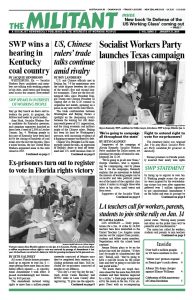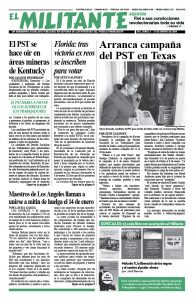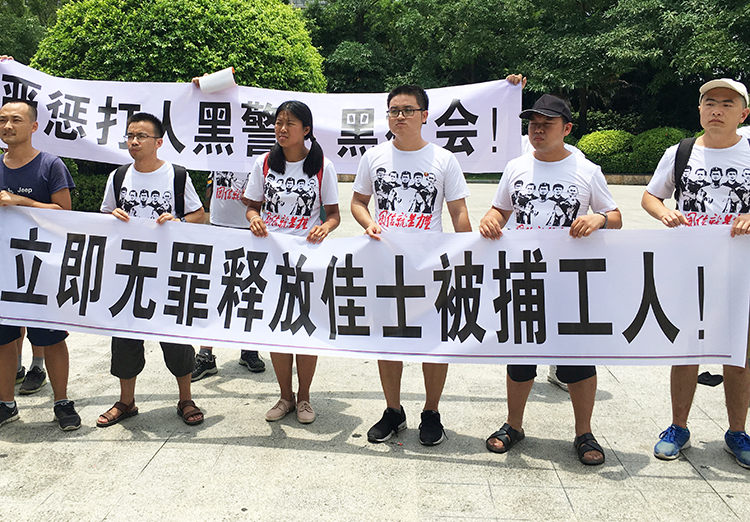U.S. and Chinese officials met in Beijing Jan. 7-9 for negotiations over the trade dispute between the rulers of the world’s first and second largest economies. These are the first announced talks since President Donald Trump and Chinese President Xi Jinping met at the G-20 summit in Argentina last month, agreeing on a pause in any new tariffs until March.
The trade confrontation between Washington and Beijing throws a spotlight on the sharpening rivalry between the waning but still dominant world power of U.S. imperialism, and the rising economic and military might of the Chinese rulers. Beijing has been hit hard by Washington’s pressure, with increasing evidence of a flagging economy burdened by debt.
Chinese Vice President Liu He unexpectedly joined the talks, an expression of Beijing’s desire to head off threatened new U.S. tariff increases from 10 to 25 percent on $250 billion worth of imports from China. The U.S. rulers are demanding less Chinese government subsidization of export prices, an end to forced technology transfers for foreign firms investing in the Chinese market, and greater protections against intellectual property theft.
The new year started with the unexpected announcement by Apple of a projected fall in sales and profits, ascribed to a weakening of the Chinese economy. In a Jan. 2 press release, Apple Chief Executive Tim Cook wrote that the company had “anticipated some challenges in key emerging markets” but didn’t “foresee the magnitude of the economic deceleration, particularly in Greater China,” a reference that includes Hong Kong and Taiwan.
In fact, the U.S.-based tech giant faces stiff competition from Chinese companies in the world’s largest smartphone market. Stock markets in the U.S. and elsewhere wobbled and a brief “flash crash” affected many currencies, as capitalist speculators worried this development presaged a broader downturn.
A key part of Apple’s production and supply chain is based in China. In mid-December, temporary workers at Foxconn, a key Apple electronics supplier, took to the streets to demand payment on promised bonuses. Their protest was broken up by police, who beat several workers and arrested others.
Decades of export-driven expansion drew millions of peasants off the land to work in factories in cities and special “economic development zones” set up near ports and trade routes. Over time Chinese workers have won pay increases.
Factory output in China has started contracting. This is partly because rising wages have led bosses in many industries, like garment, to move elsewhere in Asia where workers get paid less.
The Chinese government has been pushing to shift the state-capitalist economy from reliance on export-oriented industrialization, which underpinned three decades of boom, to expanding the domestic market. But the growing contraction in production and pressure on trade have slowed things down.
Faced with economic uncertainties, as well as rising living costs hundreds of millions in China are spending less. Yearly sales of cars by both foreign and domestic automakers fell for the first time in almost three decades. Government revenue from consumption taxes plummeted by two-thirds at the end of last year.
Pressure from Washington’s tariffs has accelerated these developments.
Growing debt load
The Chinese government’s debt load, largely the result of years of government stimulus, has climbed to $34 trillion. A new crisis can turn these loan “assets” of banks, in China and worldwide, into their opposite as bankruptcies mount.
The Chinese rulers’ problems fit with the challenges facing the capitalist moguls worldwide. Their total global debt burden has ballooned to nearly $250 trillion — up from $173 trillion at the time of the 2008 global financial crisis. This feeds the gyrations in stock markets, as fears of a new debt-fed capitalist downturn eat away at investors’ confidence.
Beijing had begun to tighten credit in an effort to rein in the debt. But with production heading downward, the rulers there have shifted gears, announcing $125 billion in infrastructure spending, mainly on big rail projects, hoping to stimulate manufacturing again.
And they feel increased pressure to reach some kind of agreement with Washington.
Stock markets turned upward Jan. 9 as the Washington-Beijing trade talks were extended for a third day. President Trump tweeted that the talks were “going very well!” Only time will tell whether the two countries’ rulers have engineered a temporary respite in their ongoing struggle over who will emerge as top dog.


